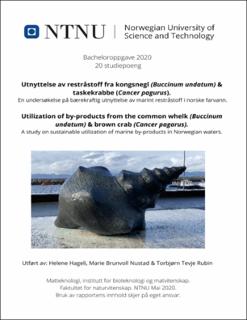| dc.description.abstract | Hensikten med bacheloroppgaven var å gjøre undersøkelser på restråstoff fra kongsnegl og taskekrabbe for å øke kunnskap rundt hvordan man i større grad kan utnytte seg av dette re-stråstoffet. Arbeidet startet med å utføre et karakteriseringsforsøk med kongsnegl, for å kart-legge størrelsesgrupper og fordeling av fraksjoner av skall, biprodukt og muskel innad i hver gruppe. Resultatene viste en gjennomsnittslengde på 77,6 mm og ingen signifikant forskjell i prosentvis utbytte av skall, muskel og biprodukt for de forskjellige størrelsesgruppene. Det ble imidlertid funnet en klar signifikant forskjell i vekt av skall, muskel og biprodukt. Resultatene viste også at det var en korrelasjon mellom økende vekt og økende lengde, samt korrelasjon mellom økende lengde og økende bredde på snegl. Restråstoff fra både kongsnegl og taske-krabbe ble analysert for innhold av protein, lipid og kadmium ved SINTEF Norlab. For kongsnegl ble analysene gjennomført på hver størrelsesgruppe. Fra analyseresultatene ble det funnet at skall fra kongsnegl ble målt til å ha et gjennomsnittlig innhold av: Protein 3,17 g/100 g, lipid 0,82 g/100 g og kadmium 0,27 mg/kg. Biprodukt fra kongsnegl ble målt til å ha et gjennomsnittlig innhold av: Protein 20,90 g/100 g, lipid 1,54 g/100 g og kadmium 8,12 mg/kg. Restråstoffet fra taskekrabbe ble funnet til å ha et gjennomsnittlig innhold av: Protein 14,70 g/100 g, lipid 0,50 g/100 g og kadmium 0,05 mg/kg.
Ut fra det utførte analysearbeidet kan det konkluderes med at det ses størst potensiale i å ut-nytte restråstoffet fra taskekrabbe. Skall fra kongsnegl har mulighet for utnyttelse, men krever videre undersøkelser for å finne ut om dette er mulig å gjennomføre industrielt på en effektiv og økonomisk måte. For biprodukt trengs det videre forskning for å redusere innhold av kadmi-um før det kan anvendes videre. Biprodukt og skall fra kongsnegl blandet gjør at det kan brukes i gjødsel. Det er vist at det er potensiale til å utnytte restråstoffet som i dag blir kassert, og at å utnytte disse ressursene bedre fordrer en bærekraftig utvikling som kan øke profitten og sam-tidig øke graden av en bærekraftig sirkulær økonomi. | |
| dc.description.abstract | The purpose of this bachelor thesis was to conduct research on marine by-products from the common whelk and the brown crab, in order to gain a better understanding of how to make better use of it. The work started by conducting a characterization experiment on the common whelk. The aim of the characterization was to map size groups and the distribution of fractions (shell, organ-fraction and muscle), within the different groups. The results showed an average length of 77.6 mm and no significant difference in the percentage yield of shell, muscle and or-gan-fraction between the different size groups. There was found a significant difference in weight of shell, muscle and organ-fraction. It was also found that there was a correlation be-tween increasing weight and increasing length, as well as a correlation between increasing length and increasing width of snails. The material from both common whelk and brown crab was analyzed for protein, lipid and cadmium content. For the common whelk, the analyzes were performed on each individual size group. From the results of the analysis it was found that snail shell had an average content of: Protein 3.17 g/100 g, lipids 0.82 g/100 g and cadmium 0.27 mg/kg. The snail organ-fraction was found to have an average content of: Protein 20.90 g/100 g, lipids 1.54g/100g and cadmium 8.12mg/kg. The by-material from brown crab was found to have an average content of: Protein 14.70 g/100 g, lipid 0.50 g/100 g and cadmium 0.05 mg/kg.
In conclusion the greatest potential can be seen in the utilization of by-material from brown crab. Shells from the common whelk have the potential for further utilization, but there would be a need for additional research in order to determine if industrial processing is viable in an efficient and cost-effective manner. To be able to utilize the organ-faction from the common whelk further research is necessary, because there is need to reduce cadmium content before use. If the organ-fraction from the common whelk is mixed with its shells it can be used as ferti-lizer. The study has shown that there is potential in exploiting the by-products that are currently being discarded, and that better utilization of these resources will aid in developing a more sus-tainable industry that can increase profits and simultaneously increase the degree of a sustain-able circular economy. | |
